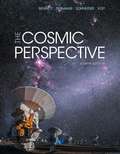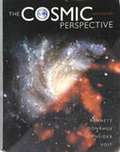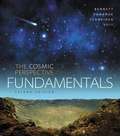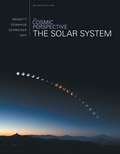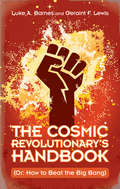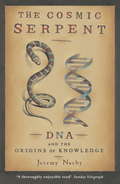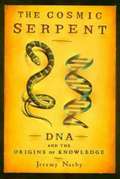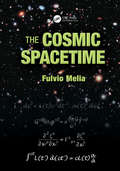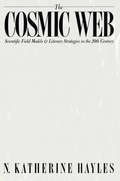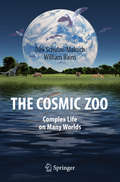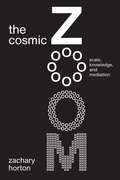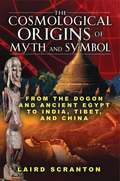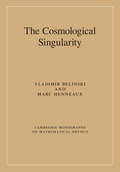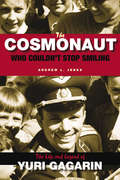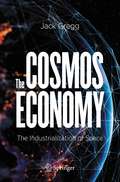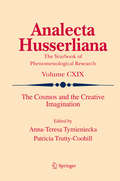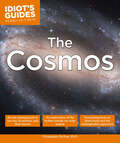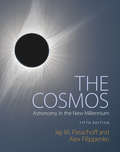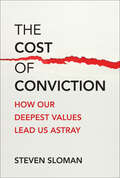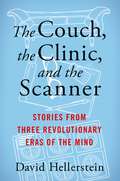- Table View
- List View
The Cosmic Perspective
by Jeffrey Bennett Mark Voit Nicholas Schneider Megan DonahueBuilding on a long tradition of effective pedagogy and comprehensive coverage, The Cosmic Perspective, Eighth Edition provides a thoroughly engaging and up-to-date introduction to astronomy for non-science majors. This text offers a wealth of features that enhance student understanding of the process of science and actively engage students in the learning process for key concepts. The fully updated Eighth Edition includes the latest scientific discoveries, revises several subjects based on our most current understanding of the cosmos, and now emphasizes deeper understanding of the twists and turns of the process of science and the relevance of concepts to student’s lives.
The Cosmic Perspective
by Jeffrey Bennett Megan Donahue Nicholas Schneider Mark VoltMaking Sense of the Universe, Telescopes, Planetary Geology, Planetary Atmospheres, Remnants of Rock and Ice.
The Cosmic Perspective Fundamentals (Bennett Science And Math Titles Series)
by Jeffrey Bennett Mark Voit Nicholas Schneider Megan DonahueTeaching the Process of Science through Astronomy <P><P> Inspired by an activities-based classroom approach, The Cosmic Perspective Fundamentals is the briefest introduction to astronomy in the Bennett series. By focusing on the process of science and fundamental concepts of astronomy, The Cosmic Perspective Fundamentals allows time for the use of other instructional tools in the course. Each concisely written chapter is formatted into two main sections followed by a Process of Science section, making learning targeted and expectations clear for students. <P><P> The Second Edition of The Cosmic Perspective Fundamentals presents recent dramatic advances in astronomy and how they change our understanding of the cosmos. This new edition focuses on essential subjects of astronomy chosen for their importance to the field, interest, and engagement level, using goal-oriented lessons and practical tools to bring astronomy to life. The textbook is now supported in Mastering Astronomy to create an unrivalled learning suite for students and instructors.
The Cosmic Perspective: The Solar System
by Jeffrey Bennett Mark Voit Nicholas Schneider Megan DonahueThe text provides a wealth of features that enhance skill-building, including new group work exercises that help you retain concepts longer and build communication skills for the future. The Seventh Edition has also been fully updated to include the latest astronomical observations, results from recent space missions, research, and theoretical developments that inform our understanding of the early universe.
The Cosmic Revolutionary's Handbook: (Or: How to Beat the Big Bang)
by Luke A. Barnes Geraint F. LewisFree yourself from cosmological tyranny! Everything started in a Big Bang? Invisible dark matter? Black holes? Why accept such a weird cosmos? For all those who wonder about this bizarre universe, and those who want to overthrow the Big Bang, this handbook gives you 'just the facts': the observations that have shaped these ideas and theories. While the Big Bang holds the attention of scientists, it isn't perfect. The authors pull back the curtains, and show how cosmology really works. With this, you will know your enemy, cosmic revolutionary - arm yourself for the scientific arena where ideas must fight for survival! This uniquely-framed tour of modern cosmology gives a deeper understanding of the inner workings of this fascinating field. The portrait painted is realistic and raw, not idealized and airbrushed - it is science in all its messy detail, which doesn't pretend to have all the answers.
The Cosmic Serpent
by Jeremy NarbyWhile living among Peruvian Indians, anthropologist Jeremy Narby became intrigued by their claim that their phenomenal knowledge of plants and biochemistry was communicated to them directly while under the influence of hallucinogens. Despite his initial scepticism, Narby found himself engaged in an increasingly obsessive personal quest. The evidence he collected - on subjects as diverse as molecular biology, shamanism, neurology and ancient mythology - led inexorably to the conclusion that the Indians' claims were literally true: to a consciousness prepared with drugs, specific biochemical knowledge could indeed be directly transmitted through DNA itself. A gripping investigation that opens fresh perspectives on biology, anthropology and the limits of rationalism, The Cosmic Serpent is new science of the most exhilarating kind.
The Cosmic Serpent: DNA and the Origins of Knowledge
by Jeremy NarbyThis adventure in science and imagination, which the Medical Tribune said might herald "a Copernican revolution for the life sciences," leads the reader through unexplored jungles and uncharted aspects of mind to the heart of knowledge. In a first-person narrative of scientific discovery that opens new perspectives on biology, anthropology, and the limits of rationalism, The Cosmic Serpent reveals how startlingly different the world around us appears when we open our minds to it.
The Cosmic Spacetime
by Fulvio MeliaThe growth of cosmology into a precision science represents one of the most remarkable stories of the past century. Much has been written chronicling this development, but rarely has any of it focused on the most critical element of this work–the cosmic spacetime itself. Addressing this lacuna is the principal focus of this book, documenting the growing body of evidence compelling us–not only to use this famous solution to Einstein's equations in order to refine the current paradigm, but–to probe its foundation at a much deeper level. Its excursion from the smallest to largest possible scales insightfully reveals an emerging link between the Universe we behold and the established tenets of our most fundamental physical theories. Key Features: Uncovers the critical link between the Local Flatness Theorem in general relativity and the symmetries informing the spacetime's metric coefficients Develops a physical explanation for some of the most unpalatable coincidences in cosmology Provides a sober assessment of the horizon problems precluding our full understanding of the early Universe Reveals a possible explanation for the origin of rest-mass energy in Einstein's theory In spite of its technical layout, this book does not shy away from introducing the principal players who have made the most enduring contributions to this field. Anyone with a graduate level foundation in physics and astronomy will be able to easily follow its contents.
The Cosmic Web: Mysterious Architecture of the Universe
by J. Richard GottJ. Richard Gott was among the first cosmologists to propose that the structure of our universe is like a sponge made up of clusters of galaxies intricately connected by filaments of galaxies--a magnificent structure now called the "cosmic web" and mapped extensively by teams of astronomers. Here is his gripping insider's account of how a generation of undaunted theorists and observers solved the mystery of the architecture of our cosmos.The Cosmic Web begins with modern pioneers of extragalactic astronomy, such as Edwin Hubble and Fritz Zwicky. It goes on to describe how, during the Cold War, the American school of cosmology favored a model of the universe where galaxies resided in isolated clusters, whereas the Soviet school favored a honeycomb pattern of galaxies punctuated by giant, isolated voids. Gott tells the stories of how his own path to a solution began with a high-school science project when he was eighteen, and how he and astronomer Mario Jurič measured the Sloan Great Wall of Galaxies, a filament of galaxies that, at 1.37 billion light-years in length, is one of the largest structures in the universe.Drawing on Gott's own experiences working at the frontiers of science with many of today's leading cosmologists, The Cosmic Web shows how ambitious telescope surveys such as the Sloan Digital Sky Survey are transforming our understanding of the cosmos, and how the cosmic web holds vital clues to the origins of the universe and the next trillion years that lie ahead.
The Cosmic Web: Scientific Field Models and Literary Strategies in the Twentieth Century
by N. Katherine HaylesFrom the central concept of the field—which depicts the world as a mutually interactive whole, with each part connected to every other part by an underlying field— have come models as diverse as quantum mathematics and Saussure’s theory of language. In The Cosmic Web, N. Katherine Hayles seeks to establish the scope of the field concept and to assess its importance for contemporary thought. She then explores the literary strategies that are attributable directly or indirectly to the new paradigm; among the texts at which she looks closely are Robert Pirsig’s Zen and the Art of Motorcycle Maintenance, Nabokov’s Ada, D. H. Lawrence’s early novels and essays, Borges’s fiction, and Thomas Pynchon’s Gravity’s Rainbow.
The Cosmic Zoo
by Dirk Schulze-Makuch William BainsAre humans a galactic oddity, or will complex life with human abilities develop on planets with environments that remain habitable for long enough? In a clear, jargon-free style, two leading researchers in the burgeoning field of astrobiology critically examine the major evolutionary steps that led us from the distant origins of life to the technologically advanced species we are today. Are the key events that took life from simple cells to astronauts unique occurrences that would be unlikely to occur on other planets? By focusing on what life does - it's functional abilities - rather than specific biochemistry or anatomy, the authors provide plausible answers to this question. Systematically exploring the various pathways that led to the complex biosphere we experience on planet Earth, they show that most of the steps along that path are likely to occur on any world hosting life, with only two exceptions: One is the origin of life itself - if this is a highly improbable event, then we live in a rather "empty universe". However, if this isn't the case, we inevitably live in a universe containing a myriad of planets hosting complex as well as microbial life - a "cosmic zoo". The other unknown is the rise of technologically advanced beings, as exemplified on Earth by humans. Only one technological species has emerged in the roughly 4 billion years life has existed on Earth, and we don't know of any other technological species elsewhere. If technological intelligence is a rare, almost unique feature of Earth's history, then there can be no visitors to the cosmic zoo other than ourselves. Schulze-Makuch and Bains take the reader through the history of life on Earth, laying out a consistent and straightforward framework for understanding why we should think that advanced, complex life exists on planets other than Earth. They provide a unique perspective on the question that puzzled the human species for centuries: are we alone?
The Cosmic Zoom: Scale, Knowledge, and Mediation
by Zachary HortonIn The Powers of Ten by Charles and Ray Eames, a view of two people enjoying a picnic zooms up and away to show their surroundings, moving progressively farther into space, then zooms back in for a close-up of the hand of the picnicker, travelling deep into the microscopic realm. This is one of the most iconic examples of the “cosmic zoom,” a trope that has influenced countless media forms over the past seventy years. Horton uses the cosmic zoom as a starting point to develop a cross-disciplinary theory of scale as mediated difference. He considers the origins of our notions of scale, how scalar mediation functions differently in analog and digital modes, and how cosmic zoom media has influenced scientific and popular views of the world. Analyzing literature, film, digital media, and database history, Horton establishes a much-needed framework for thinking about scale across multiple domains and disciplines.
The Cosmological Origins of Myth and Symbol: From the Dogon and Ancient Egypt to India, Tibet, and China
by Laird ScrantonReconstructs a theoretic parent cosmology that underlies ancient religion • Shows how this parent cosmology provided the conceptual origins of written language • Uses techniques of comparative cosmology to synchronize the creation traditions of the Dogon, ancient Egyptians, and ancient Buddhists • Applies the signature elements of this parent cosmology to explore and interpret the creation tradition of a present-day Tibetan/Chinese tribe called the Na-Khi--the keepers of the world’s last surviving hieroglyphic language Great thinkers and researchers such as Carl Jung have acknowledged the many broad similarities that exist between the myths and symbols of ancient cultures. One largely unexplored explanation for these similarities lies in the possibility that these systems of myth all descended from one common cosmological plan. Outlining the most significant aspects of cosmology found among the Dogon, ancient Egyptians, and ancient Buddhists, including the striking physical and cosmological parallels between the Dogon granary and the Buddhist stupa, Laird Scranton identifies the signature attributes of a theoretic ancient parent cosmology--a planned instructional system that may well have spawned these great ancient creation traditions. Examining the esoteric nature of cosmology itself, Scranton shows how this parent cosmology encompassed both a plan for the civilized instruction of humanity as well as the conceptual origins of language. The recurring shapes in all ancient religions were key elements of this plan, designed to give physical manifestation to the sacred and provide the means to conceptualize and compare earthly dimensions with those of the heavens. As a practical application of the plan, Scranton explores the myths and language of an obscure Chinese priestly tribe known as the Na-Khi--the keepers of the world’s last surviving hieroglyphic language. Suggesting that cosmology may have engendered civilization and not the other way around, Scranton reveals how this plan of cosmology provides the missing link between our macroscopic universe and the microscopic world of atoms.
The Cosmological Singularity (Cambridge Monographs on Mathematical Physics)
by Marc Henneaux Vladimir BelinskiWritten for researchers focusing on general relativity, supergravity, and cosmology, this is a self-contained exposition of the structure of the cosmological singularity in generic solutions of the Einstein equations, and an up-to-date mathematical derivation of the theory underlying the Belinski-Khalatnikov-Lifshitz (BKL) conjecture on this field. Part I provides a comprehensive review of the theory underlying the BKL conjecture. The generic asymptotic behavior near the cosmological singularity of the gravitational field, and fields describing other kinds of matter, is explained in detail. Part II focuses on the billiard reformulation of the BKL behavior. Taking a general approach, this section does not assume any simplifying symmetry conditions and applies to theories involving a range of matter fields and space-time dimensions, including supergravities. Overall, this book will equip theoretical and mathematical physicists with the theoretical fundamentals of the Big Bang, Big Crunch, Black Hole singularities, the billiard description, and emergent mathematical structures.
The Cosmonaut Who Couldn't Stop Smiling: The Life And Legend Of Yuri Gagarin
by Andrew Jenks"Let’s go!" With that, the boyish, grinning Yuri Gagarin launched into space on April 12, 1961, becoming the first human being to exit Earth’s orbit. The twenty-seven-year-old lieutenant colonel departed for the stars from within the shadowy world of the Soviet military-industrial complex. Barbed wires, no-entry placards, armed guards, false identities, mendacious maps, and a myriad of secret signs had hidden Gagarin from prying outsiders not even his friends or family knew what he had been up to. Coming less than four years after the Russians launched Sputnik into orbit, Gagarin’s voyage was cause for another round of capitalist shock and Soviet rejoicing. The Cosmonaut Who Couldn’t Stop Smiling relates this twentieth-century icon’s remarkable life while exploring the fascinating world of Soviet culture.
The Cosmonaut Who Couldn’t Stop Smiling: The Life and Legend of Yuri Gagarin (NIU Series in Slavic, East European, and Eurasian Studies)
by Andrew L. Jenks“Let's go!” With that, the boyish, grinning Yuri Gagarin launched into space on April 12, 1961, becoming the first human being to exit Earth's orbit. The twenty-seven-year-old lieutenant colonel departed for the stars from within the shadowy world of the Soviet military-industrial complex. Barbed wires, no-entry placards, armed guards, false identities, mendacious maps, and a myriad of secret signs had hidden Gagarin from prying outsiders—not even his friends or family knew what he had been up to. Coming less than four years after the Russians launched Sputnik into orbit, Gagarin's voyage was cause for another round of capitalist shock and Soviet rejoicing. The Cosmonaut Who Couldn't Stop Smiling relates this twentieth-century icon's remarkable life while exploring the fascinating world of Soviet culture. Gagarin's flight brought him massive international fame—in the early 1960s, he was possibly the most photographed person in the world, flashing his trademark smile while rubbing elbows with the varied likes of Nehru, Castro, Queen Elizabeth II, and Italian sex symbol Gina Lollobrigida. Outside of the spotlight, Andrew L. Jenks reveals, his tragic and mysterious death in a jet crash became fodder for morality tales and conspiracy theories in his home country, and, long after his demise, his life continues to provide grist for the Russian popular-culture mill. This is the story of a legend, both the official one and the one of myth, which reflected the fantasies, perversions, hopes and dreams of Gagarin's fellow Russians. With this rich, lively chronicle of Gagarin's life and times, Jenks recreates the elaborately secretive world of space-age Russia while providing insights into Soviet history that will captivate a range of readers.
The Cosmos
by Jay M. Pasachoff Alex FilippenkoJay Pasachoff and Alex Filippenko combine extensive research experience (including years of research in such areas as radio astronomy, solar eclipses, supernovae, active galaxies, black holes, and cosmology), teaching experience, and textbook-writing experience to offer a book that is unparalleled in its ability to present the latest science in a way that students can understand. This brief and beautifully illustrated text ? one of the briefest available for the course ? offers concise coverage of a wide range of astronomical topics. An early discussion of the scientific method stresses its importance in the verification of observations. The authors emphasize the study of origins in this text, first by singling out specifics in the headings of each chapter and then by dealing with a variety of relevant material in the text itself. This new edition includes a new chapter on the dozens of exoplanets that are being discovered around other stars. Automatically packaged with TheSky? CD-ROM and four months' free access to InfoTrac College Edition, the new edition extends student learning opportunities beyond the walls of the classroom.
The Cosmos Economy: The Industrialization of Space
by Jack GreggIf man’s next big step is to live and work in space, then what will everyone do out there that is so different from what we are now doing here on Earth? As the future of space comes into focus it is clear that profit and power are the core elements of the new space economy. This entertaining and informative book looks at human settlement in space as a mainstream business opportunity for investors, entrepreneurs and far-sighted individuals seeking to secure their place in the innovative commercial space sector. Dr. Jack Gregg presents a unique 5-phase development roadmap that shows how space will grow from a frontier economy to a mature integrated market. Written in simple, non-technical language, this book answers such questions as:• What is the new industrial space economy?• What are the challenges and roadblocks on the way to a robust space economy?• How will the rapid growth of the new space economy impact commerce back on Earth?• How can one best invest in profitable space-related enterprises? The Cosmos Economy is for readers who hope to be better equipped and more informed about the new space economy; and Investors, entrepreneurs, and futurists who wants to learn how to take part in the business opportunities of the new high frontier of commercial space.
The Cosmos and the Creative Imagination
by Anna-Teresa Tymieniecka Patricia Trutty-CoohillThe essays in this book respond to Anna-Teresa Tymieniecka's recent call to explore the relationship between the evolution of the universe and the process of self-individuation in the ontopoietic unfolding of life. The essays approach the sensory manifold in a number of ways. They show that theories of modern science become a strategy for the phenomenological study of works of art, and vice versa. Works of phenomenology and of the arts examine how individual spontaneity connects with the design(s) of the logos - of the whole and of the particulars - while the design(s) rest not on some human concept, but on life itself. Life's pliable matrices allow us to consider the expansiveness of contemporary science, and to help create a contemporary phenomenological sense of cosmos.
The Cosmos: An Eye-Opening Look at Our Sun, Its Planets, and Their Moons (Idiot's Guides)
by Christopher De PreeMajor new discoveries in space are made almost weekly and there is so much for any new enthusiast to learn and explore. Beginning with the solar system, the Sun, all its planets, major moons, and other features, such as the asteroid belt, Idiot's Guides: The Cosmos is packed with information and features the best photos from various explorations. Beautiful photography and detailed descriptions of the various types of masses are compared to Earth-- making the information as easy to grasp as possible. The book also explores the Milky Way, the various star types, including black holes, galaxy filaments, and much more.Idiot's Guides: The Cosmos is a fascinating and easy-to-understand exploration of the universe. Dozens of stunning, full-color photos highlight the latest discoveries and beauty of space, including the solar system, the Sun, the asteroid belt, the Milky Way, various star types, black holes, and more.
The Cosmos: Astronomy in the New Millennium
by Jay M. Pasachoff Alex FilippenkoThe fifth edition of The Cosmos: Astronomy in the New Millennium provides you with the fundamentals of astronomical knowledge that have been built up over decades, with an expanded discussion of the incredible advances that are now taking place in this fast-paced field, such as New Horizons' flyby of Pluto, exoplanets, 'dark matter', and the direct detection of gravitational waves by the Laser Interferometer Gravitational-Wave Observatory (LIGO). Written in a clear and easily understandable style, this textbook has been thoroughly revised to include updated data and figures, new images from recent space missions and telescopes, the latest discoveries on supernovae, and new observations of the region around the four-million-solar-mass black hole at the center of our Milky Way Galaxy. A rich array of teaching and learning resources is available at http://thecosmos5.com. The website is regularly updated to include the latest discoveries and photographs in the field.
The Cost of Conviction: How Our Deepest Values Lead Us Astray
by Steven SlomanA timely and important perspective on how people frame decisions and how relying on sacred values unwittingly leads to social polarization.When you are faced with a decision, do you consider the best outcome, or do you consider your deepest values about which actions are appropriate? The Cost of Conviction contrasts these two primary strategies for making decisions: consequentialism or prioritizing one&’s sacred values. Steven Sloman argues that, while both modes of decision making are necessary tools for a good decision maker, people err by deploying sacred values more often than they should, especially when it comes to sociopolitical issues. As a result, we oversimplify, grow disgusted and angry, and act in ways that contribute to social polarization. In this book, Sloman provides a new understanding of today&’s societal ills and grounds that understanding in science.Drawing on historical and current examples of the two decision-making strategies in action, the author provides a thorough overview of the psychology of decision making, including work on judgment, conscious and unconscious decision-making processes, the roles of emotion, and even an analysis of habit and addiction. With its unique emphasis on sacred values, The Cost of Conviction is an eye-opening must-read for all decision makers, especially those who wish to understand judgment, social decision making, and leadership.
The Costs and Benefits of Animal Experiments
by Andrew KnightA comprehensive review of recent scientific evidence examining the contributions of animal experimentation to human healthcare. The book also explores toxicity prediction, animal use during life and health sciences education, impacts on student attitudes toward animals, and the extent to which animals suffer in laboratories.
The Costs of the Common Agricultural Policy (Routledge Library Editions: Agriculture #7)
by Kenneth J. Thomson Allan E. Buckwell David R. Harvey Kevin A. PartonFirst published in 1982. Considerable public controversy surrounded the large amount of public expenditure devoted to agriculture under the European Community’s Common Agricultural Policy (CAP). There were serious disputes over how the farm support system operated and how it was financed. This book describes the CAP situation and summarises previous attempts to assess some of the economic and financial flows arising from its creation using a common framework of well-established economic theory and methods. The CAP turned out to have a number of ‘costs’, depending on the concept of ‘cost’ used, the alternative policies considered, and the various assumptions made. The bulk of the book presents the structure and results of a comprehensive model of European Community agricultural markets and the associated CAP support mechanisms. This model is validated against official Community budget figures and then run to simulate a number of policy options and their consequences. This title will be of interest to students of economics, geography and agriculture.
The Couch, the Clinic, and the Scanner: Stories from Three Revolutionary Eras of the Mind
by David HellersteinOver the past several decades, psychiatry has undergone radical changes. After its midcentury heyday, psychoanalysis gave way to a worldview guided by the Diagnostic and Statistical Manual, which precisely defined mental disorders and their treatments; more recently, this too has been displaced by a model inspired by neuroscience. Each of these three dominant models overturned the previous era’s assumptions, methods, treatment options, and goals. Each has its own definitions of health and disease, its own concepts of the mind. And each has offered clinicians and patients new possibilities as well as pitfalls.The Couch, the Clinic, and the Scanner is an insightful first-person account of psychiatry’s evolution. David Hellerstein—a psychiatrist who has practiced in New York City since the early 1980s, working with patients, doing research, and helping run clinics and hospitals—provides a window into how the profession has transformed. In vivid stories and essays, he explores the lived experience of psychiatric work and the daunting challenges of healing the mind amid ever-changing theoretical models. Recounting his intellectual, clinical, and personal adventures, Hellerstein finds unexpected poetry in hallways and waiting rooms; encounters with patients who are by turns baffling, frustrating, and inspiring; and the advances of science. Drawing on narrative-medicine approaches, The Couch, the Clinic, and the Scanner offers a perceptive and eloquent portrayal of the practice of psychiatry as it has struggled to define and redefine itself.
